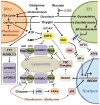Signal integration by mTORC1 coordinates nutrient input with biosynthetic output
- PMID: 23728461
- PMCID: PMC3743096
- DOI: 10.1038/ncb2763
Signal integration by mTORC1 coordinates nutrient input with biosynthetic output
Abstract
Flux through metabolic pathways is inherently sensitive to the levels of specific substrates and products, but cellular metabolism is also managed by integrated control mechanisms that sense the nutrient and energy status of a cell or organism. The mechanistic target of rapamycin complex 1 (mTORC1), a protein kinase complex ubiquitous to eukaryotic cells, has emerged as a critical signalling node that links nutrient sensing to the coordinated regulation of cellular metabolism. Here, we discuss the role of mTORC1 as a conduit between cellular growth conditions and the anabolic processes that promote cell growth. The emerging network of signalling pathways through which mTORC1 integrates systemic signals (secreted growth factors) with local signals (cellular nutrients - amino acids, glucose and oxygen - and energy, ATP) is detailed. Our expanding understanding of the regulatory network upstream of mTORC1 provides molecular insights into the integrated sensing mechanisms by which diverse cellular signals converge to control cell physiology.
Conflict of interest statement
COMPETING FINANCIAL INTERESTS
The authors declare that they have no competing financial interests related to this work.
Figures




References
-
- Weichhart T, Saemann MD. The multiple facets of mTOR in immunity. Trends Immunol. 2009;30:218–226. - PubMed
Publication types
MeSH terms
Substances
Grants and funding
LinkOut - more resources
Full Text Sources
Other Literature Sources

